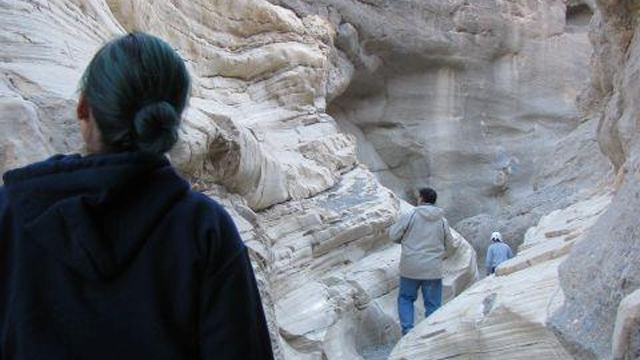…to the base of a dry waterfall…
…to a wall of raw, exposed rock, the very bones of the Black Mountains…
…and reach out a hand, pressing palm and fingers firmly to the stuff.
Ahh….
1.7 billion years old; that rock I touched had been rock (albeit slowly transforming) for over a third of Earth's existence, and over a tenth the age of the universe itself. I don't know about you, but I find that awesome! And I had my hand right on it!
When we talk about the age of a rock, it is measured from the time the rock solidified ("aggregated"), either with the cooling of molten lava or magma, or the solidification of sediment. Finding really old rocks on Earth is complicated by weather and geologic processes, which continually transform, bury, and "disaggregate" them. Even so, very old rock can be found in certain places, like Greenland, Canada, Australia, and Africa. We're talking about ages between 2.5 and 3.8 billion years, and maybe more. I'd like to get my hand on some of that!
Get away from Earth and its rock-disaggregating processes and you can find some much older stuff. On the Moon, pretty much all of the material you find lying about is at least twice as old as that stuff I put my hand on at the base of the Black Mountains. On the Moon, significant surface activity (volcanism, bombardment by asteroids) ended some 3 billion years ago, and since then the crust has remained more or less unchanged, other than alterations caused by the occasional meteorite impact. The youngest rocks on the Moon are about the same age as most of the Earth's oldest stuff.
We even have a piece of that old stuff at Chabot: a chunk of 3.3 billion year old basalt brought back by Apollo 15 astronauts--and the only things that separate my hand from its speckly gray surface are two panes of glass and some nitrogen gas. Alas!
Get out to an asteroid or a comet and you may very well be setting foot on stuff that's over 4.5 billion years old, unchanged since the formation of our solar system! Within our solar system, that's about as old as stuff gets, but venture beyond it, perhaps to a planetary system that is older than ours, and you'll undoubtedly find older stuff! (This blog post is beginning to ring of George Carlin material.)
But what's the oldest stuff? I can't give you a rock of age beyond a certain point in time, because it took the early universe some time to develop the elements needed to build rocks-as-we-know-them, through nucleosynthesis in the cores of stars. Before that time, the only "stuff" around (at least that we would recognize as stuff; we won't go into dark stuff right now) was hydrogen and helium, which cannot by themselves a rock make.
But that primordial hydrogen and helium, the original building blocks of all material substances, has been around almost from the beginning of time, 13.7 billion years ago, soon after the Big Bang burst forth on the scene (whatever scene that may have been). Hydrogen, found in every water molecule in every glass of water you drink, in vast abundance within the oceans and waterways of the Earth, and through and through your own body, head to toe, is stuff we live and breathe, and is as old as the universe itself!
I don't know about you, but I find that spine-tingling.

